 W
WTwo years after the end of the Estonian War of Independence (1918-1920), the Estonian Army consisted of 3 field divisions and a number of small independent battalions and companies (1922).
 W
WOperation Albion was a German air, land and naval operation in October 1917 to occupy the West Estonian Archipelago, part of the Autonomous Governorate of Estonia, Russian Republic. The land campaign opened with landings at the Tagalaht, Saaremaa, on 12 October 1917, after extensive naval operations to clear mines and subdue coastal artillery batteries. The Germans secured the island by 16 October and the Russian Army evacuated Muhu on 20 October.
 W
WThe Baltic Fleet is the fleet of the Russian Navy in the Baltic Sea.
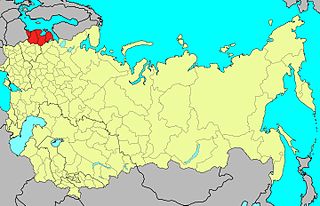 W
WThe Baltic Military District was a military district of the Soviet armed forces in the occupied Baltic states, formed briefly before the German invasion during the World War II. After end of the war the Kaliningrad Oblast was added to the District's control in 1946, and the territory of Estonia was transferred back to the Baltic Military District from the Leningrad Military District in 1956. The Baltic Military District was disbanded after the fall of the Soviet Union in 1991 and reorganised into the North Western Group of Forces, which ended its existence after withdrawal of all Russian troops from Estonia, Latvia and Lithuania on 1 September 1994.
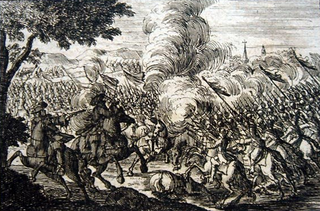 W
WBattle of Hummelshof took place on July 19, 1702 (O.S.) near the small town Hummelshof in Swedish Livonia. It was the second significant Russian victory in the Great Northern War.
 W
WThe Battle of Karuse or Battle on the Ice was fought on 16 February 1270 between the Grand Duchy of Lithuania and the Livonian Order on the frozen Baltic Sea between the island of Muhu and the mainland. The Lithuanians achieved a decisive victory. The battle, named after the village of Karuse, was the fifth-largest defeat of the Livonian or Teutonic Orders in the 13th century. Almost all that is known about the battle comes from the Livonian Rhymed Chronicle, which devoted 192 lines to the battle.
 W
WThe battle of Erastfer took place on 29 December 1701 (O.S.) / 30 December 1701 / 9 January / 1702 (N.S.) near Erastfer in eastern Swedish Livonia between a Russian force of around 13,000 regulars along with 6,000 irregulars led by general Boris Sheremetev and a Swedish force of about 3,470 men, under the command of Wolmar Anton von Schlippenbach. The Swedes were defeated, with a loss of 1,000 men killed and captured along with all their artillery pieces. The Russians sustained about 1,000 killed along with another 2,000 wounded. It was the first significant Russian victory in the Great Northern War. Before invading Ingria, Peter the Great secured Poland's continued participation in the war against Sweden by promising King Augustus II of Poland, 20,000 Russian troops, 100,000 pounds of gunpowder, and 100,000 rubles per year over three years.
 W
WThe occupation of Estonia by the German Empire occurred during the later stages of the First World War. On October 11–21, 1917, the Imperial German Army occupied the West Estonian archipelago, consisting of the islands of Saaremaa (Ösel), Hiiumaa (Dagö), and Muhu (Mühn).
 W
WThe Guerrilla war in the Baltic states or the Forest Brothers resistance movement was the armed struggle against Soviet rule that spanned from 1940 to the mid-1950s. After the occupation of the Baltic territories by the Soviets in 1944, an insurgency started. According to some estimates, 10,000 partisans in Estonia, 10,000 partisans in Latvia and 30,000 partisans in Lithuania and many more supporters were involved. This war continued as an organised struggle until 1956 when the superiority of the Soviet military caused the native population to adopt other forms of resistance. The guerrilla movement in the post-war Baltic states was of a size proportionately similar to that of the Viet Cong in South Vietnam.
 W
WThe Kalev class consisted of two mine laying submarines built for the Estonian Navy.
 W
WThe Kurkse tragedy occurred on 11 September 1997, when 14 Estonian soldiers of the Baltic Battalion drowned in the Kurkse Strait during a dangerous training maneuver. The Kurkse tragedy was the deadliest accident in the Estonian Defence Forces since the country regained independence in 1991.
 W
WThe Livonian Crusade refers to the various Christianization campaigns in the area constituting modern Lithuania, Latvia and Estonia during the Papal-sanctioned Northern Crusades. It was conducted mostly by Germans from the Holy Roman Empire and Danes. It ended with the creation of the Terra Mariana and Duchy of Estonia. The lands on the eastern shores of the Baltic Sea were the last corners of Europe to be Christianized.
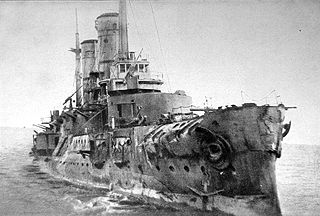 W
WThe Battle of Moon Sound was a naval battle fought between the forces of the German Empire, and the then Russian Republic in the Baltic Sea from 16 October 1917 until 3 November 1917 during World War I. The German intention was to destroy the Russian forces and occupy the West Estonian Archipelago. The Imperial German Navy had 1 battlecruiser, 10 battleships, 9 light cruisers, 1 mine cruiser, 50 destroyers and 6 submarines while the Russians had only 2 pre-dreadnoughts, 3 cruisers, 3 gunboats, 21 destroyers, plus 3 British submarines.
 W
WThe Siege of Narva, also known as the Second Battle of Narva, was the second Russian siege of Swedish Narva during the Great Northern War from 27 June to 9 August 1704.
 W
WThe Siege of Narva was a Russian siege of the Livonian city of Narva from April through May 1558, during the Livonian War. After capturing the city in July 1558, the Russians used Narva as a trading center and port to transport commerce from Pskov and Novgorod. The Russians controlled the city until 1581, when it was captured by Swedish forces under Pontus De La Gardie.
 W
WThe Soviet occupation of the Baltic states covers the period from the Soviet–Baltic mutual assistance pacts in 1939, to their invasion and annexation in 1940, to the mass deportations of 1941.
 W
WThe Soviet Union occupied most of the territory of the Baltic states in its 1944 Baltic Offensive during World War II. The Red Army regained control over the three Baltic capitals and encircled retreating Wehrmacht and Latvian forces in the Courland Pocket where they held out until the final German surrender at the end of the war. The German forces were deported and the leaders of Latvian collaborating forces were executed as traitors. After the war, the Baltic territories were reorganized into constituent republics of the USSR until they declared independence in 1990 amid the collapse of the Soviet Union.
 W
WThe Omakaitse was a militia organisation in Estonia. It was founded in 1917 following the Russian Revolution. On the eve of the Occupation of Estonia by the German Empire the Omakaitse units took over major towns in the country allowing the Salvation Committee of the Estonian Provincial Assembly to proclaim the independence of Estonia. After the German Occupation the Omakaitse became outlawed.
 W
WThe Scouts Battalion is a battalion of the Estonian Land Forces. It is a part of the 1st Infantry Brigade and acts as its rapid response unit. The battalion is currently based at Tapa and is commanded by Lieutenant colonel Eero Aija.
 W
WThe Siege of Fellin took place between March 25 and 17 May 1602 during the Polish–Swedish War (1600–1611). Polish and Lithuanian forces led by Grand Crown Hetman Jan Zamoyski besieged the Swedish-held town of Fellin. The large Polish–Lithuanian army of around 5,000 troops first took the town, while the Swedish defenders, numbering around 800, retreated to the city's castle. After a second frontal attack on the castle, during which the Voivode of Wenden Jerzy Farensbach was killed, the Swedish garrison capitulated, although a group of Finnish soldiers refused to surrender and blew themselves up in the castle's tower. Fellin was later recaptured by the Swedes in the siege of 1608.
 W
WThe Siege of Pärnu took place between February 28 and March 2, 1609 during the Polish–Swedish War (1600–1611).
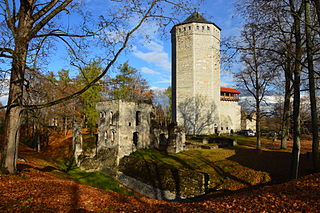 W
WThe Siege of Weissenstein took place between May 31 and September 30, 1602, during the Polish–Swedish War (1600–11). Two weeks after the capture of Fellin, Grand Crown Hetman Jan Zamoyski led the Polish-Lithuanian army of 2,000 troops to besiege Weissenstein. Weissenstein, a major transportation hub in Estonia, was a site of strategic importance to both Poland and Sweden. Located among the marshes and built during the Teutonic period, the castle had strong artillery and was defended by 700 soldiers, local peasants, and townspeople. Weissenstein was a walled city with 30-meter towers at the corners and high bastions, and thus presented the attacking force with a significant barrier to success, even with siege works.
 W
WThe Swedish Lion or The lion monument are two statues erected as monuments of the battle of Narva in 1700 in the city of Narva in Estonia.
 W
WThe Defence Forces Cemetery of Tallinn, sometimes called the Tallinn Military Cemetery, is one of the three cemeteries of the Tallinn City Centre Cemetery. It is situated about 3 kilometres outside the centre of Tallinn, the capital of Estonia. During Estonian independence before the Soviet and German occupations of the 1940-1991 period, it was the Estonian equivalent of Arlington National Cemetery in the USA - the foremost military cemetery of independent Estonia.
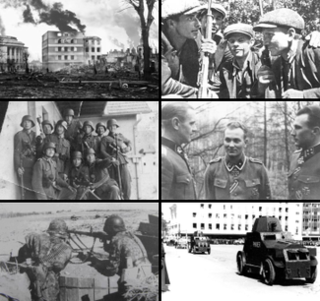 W
WBefore the outbreak of the Second World War, Germany and the Soviet Union signed the German-Soviet Nonaggression Pact, concerning the partition and disposition of sovereign states, including Estonia, and in particular its Secret Additional Protocol of August 1939.